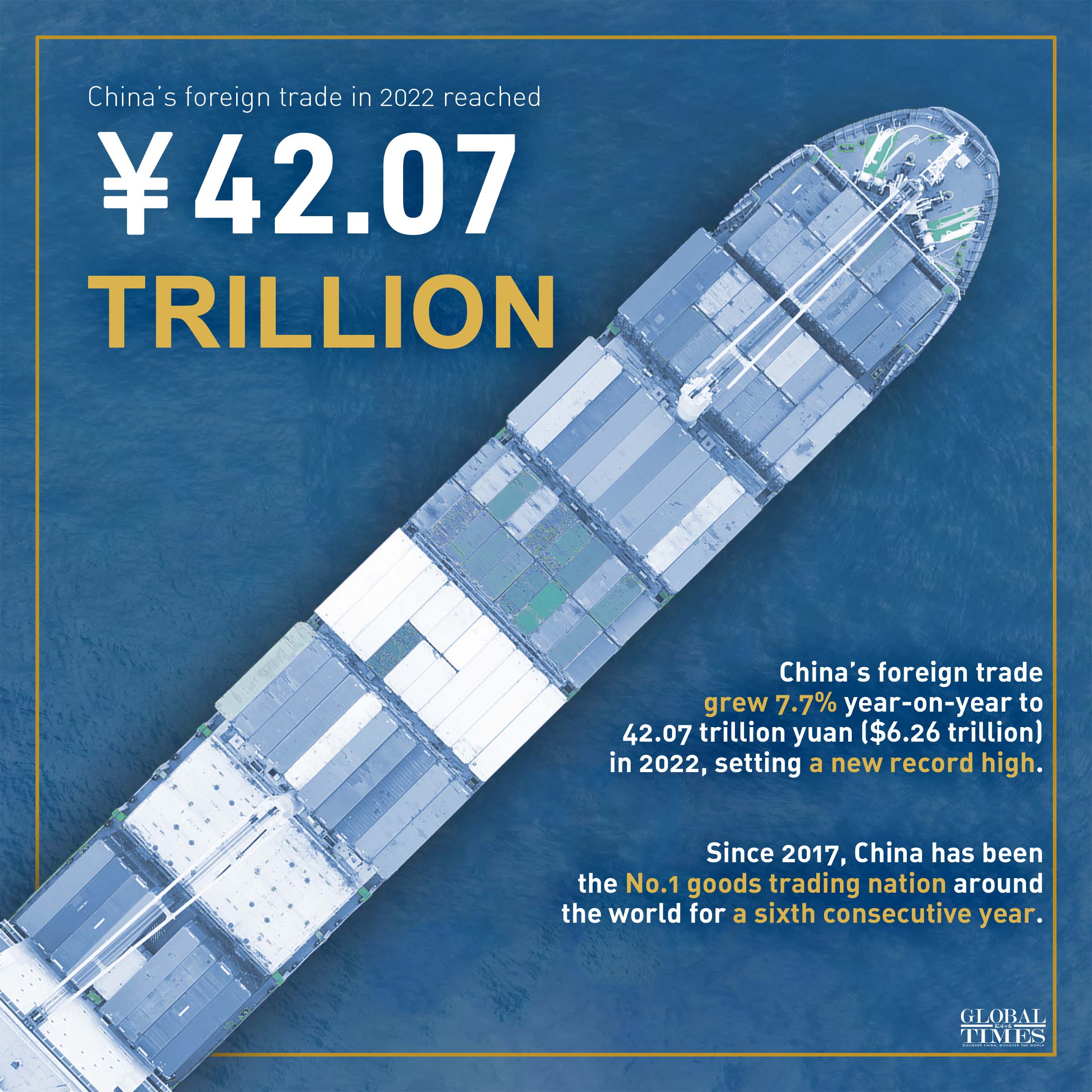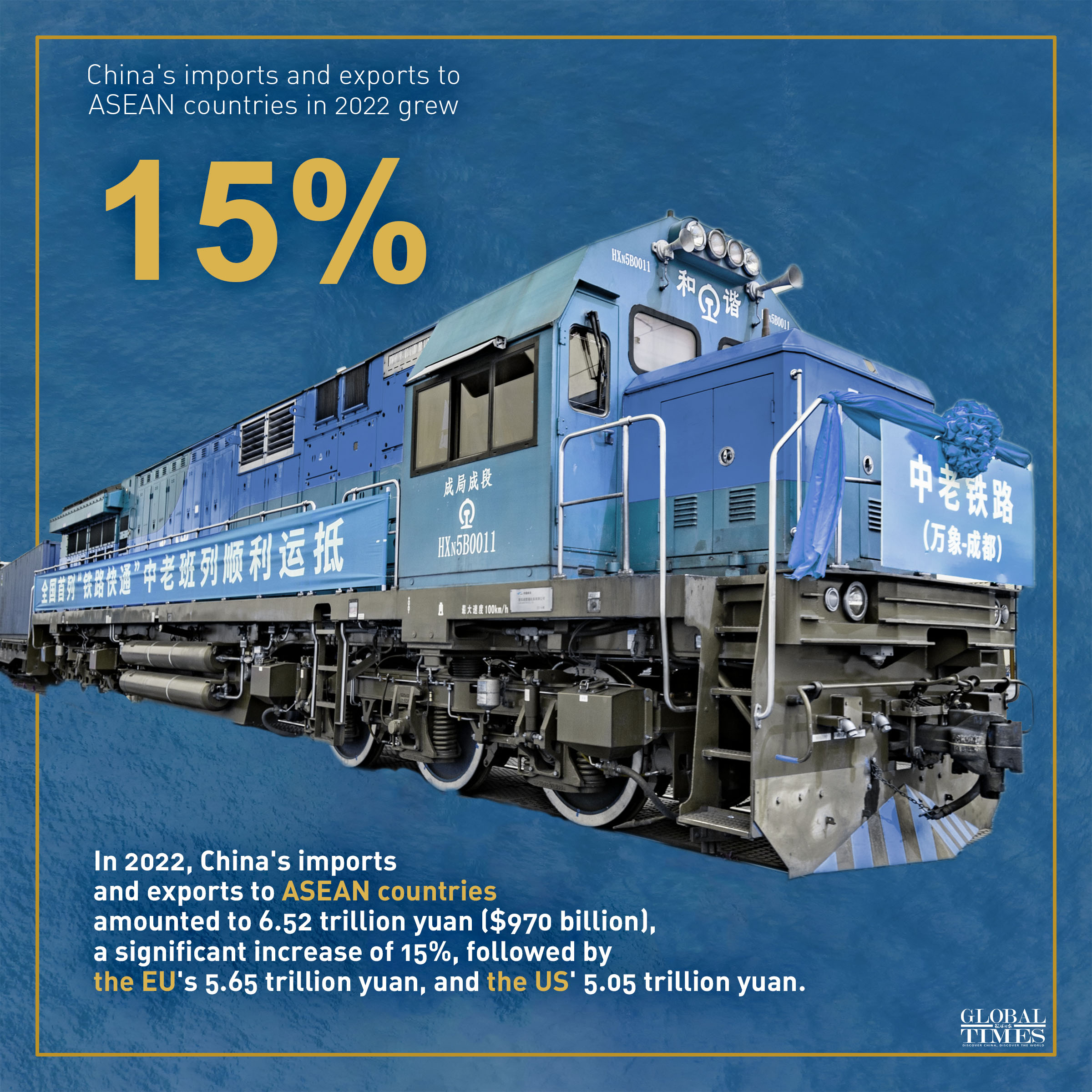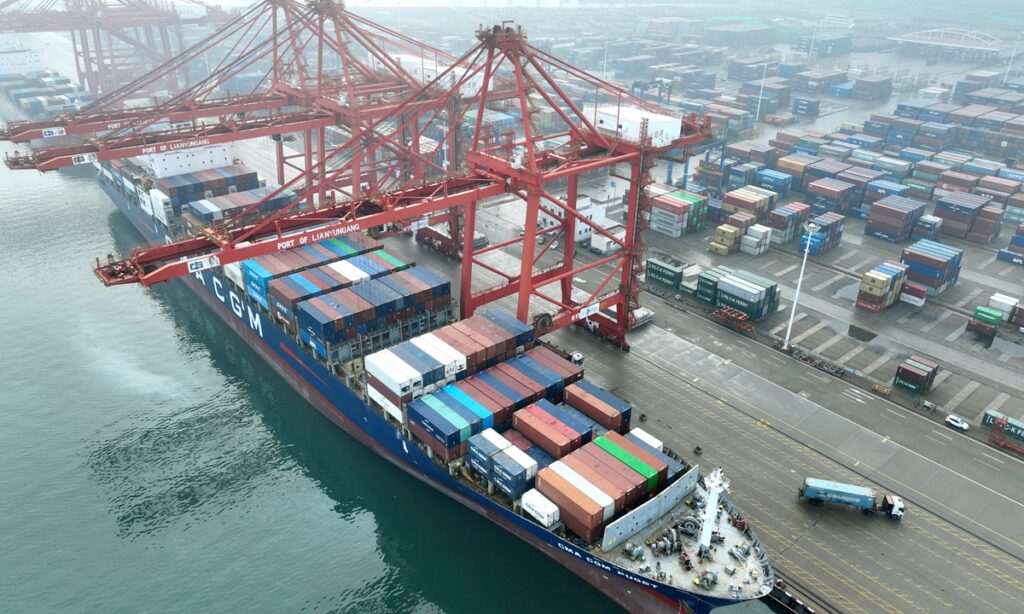The mighty Chinese trade engine overcame a number of difficulties including coronavirus lockdowns and faltering overseas demand to exceed 40 trillion yuan ($5.96 trillion) for the first time in history in 2022, data released by the Chinese customs showed on Friday, demonstrating the resilience and ability of China’s trade sector to withstand pressure, which economists hailed as being the real tower of strength sup-porting global supply chain stability in the past three years.
They also forecast that China’s trade will maintain stable growth in 2023, as the country has recently moved to optimize COVID management and as China’s trade structure continued to improve, although the export sector will come under some extra pressure with looming slowdown risks among major global economies.
In renminbi terms, China’s total goods imports and exports surged 7.7 percent year-on-year to 42.07 trillion yuan ($6.26 trillion) in 2022, hitting a new record. The country’s exports achieved a double digit growth of 10.5 percent last year to 24 trillion yuan, while imports rose by 4.3 percent. The trade surplus swelled to 5.9 trillion yuan from 2021’s level of 5.3 trillion yuan, reflecting the strength of the country’s exports.

China’s foreign trade in 2022 surpasses 40 trillion yuan for the first time. Graphic: GT
Bright spots
China’s record-setting trade performance, which happened in a year of many external and internal headwinds ranging from the Ukraine crisis to China’s COVID outbreaks, is a vivid illustration of China’s trade competence, which experts said reached a level of being “unprecedentedly strong.”
“It definitely was not easy for China to achieve a trade growth in 2022 that is expected to be largely higher than China’s and the world’s economic growth. It is a vivid reflection of the resilience of China’s trade sector, which is sure to provide strong sup-port for the country’s economic recovery,” Zhou Maohua, an economist at Everbright Bank, told the Global Times on Friday.
Detailed trade data unveiled by customs authorities showed that China’s trade sector has a number of highlights. For one thing, outbound supply of certain China-made goods such as mechanical and electrical products continued to be stable.
Lü Daliang, the customs spokesperson, revealed during a press conference on Friday that China’s exports of solar cells, lithium batteries and automobiles increased by 67.8 percent, 86.7 percent and 82.2 percent respectively in 2022.
Exports of labor-intensive products were also robust, with exports of bags, shoes and toys increasing by 32.6 percent, 24.4 percent and 9.1 percent respectively last year.
Meanwhile, imports surged in certain product categories. Last year, China imported 3.19 trillion yuan in energy products such as crude oil, natural gas and coal, accounting for 17.6 percent of the total import value. The import volume of agricultural products was 1.57 trillion yuan, up 10.8 percent year-on-year, the customs data showed.
Trade companies’ business operations were also vigorous last year. In 2022, the total number of China’s foreign trade enterprises surged by 5.6 percent to stand at 598,000. Among them, more than 500,000 are private enterprises whose trade amounted to 21.4 trillion yuan, up 12.9 percent on a yearly basis.
Chen Jing, vice president of the Technology and Strategy Research Institute, told the Global Times on Friday that China’s trade stability is backed by strong manufacturing strength, as the country’s production factors have virtually no weak spots in the manufacturing sector.
“China can cope with almost all problems emerging in the manufacturing sector including inflation, coronavirus and so on. This is something that other countries, even some global manufacturing powerhouses, are incapable of,” Chen said.
He called particular attention to the fact that China’s manufacturing industries have withstood the test of a second-quarter economic fall triggered by the two-month Shanghai lockdown, as the incident didn’t have the detrimental impact on China’s general trade sector that some foreign media had expected.
“It fully testifies to the fact that trade is China’s dominant industry, which has made huge contributions to stabilizing China’s general economy in 2022,” Chen said.
According to Zhou, the key reason why China’s foreign trade sector was able to achieve a new high last year is the effective coordination of epidemic prevention and production recovery, as well as a timely rollout of targeted rescue support measures aimed at stabilizing foreign trade companies’ confidence.

China’s foreign trade in 2022 surpasses 40 trillion yuan for the first time. Graphic: GT
Contribution to the world
In the past three years, when geopolitical tensions were rife and when many developed countries were hit by economic downturns, China’s supplies made huge contributions to stabilizing global prices and supply chains, which made China a “mainstay” in global supply and industrial chains, experts noted.
Many products that China supplied to the world over the past three years are of critical importance to people’s livelihoods. For example, in 2021 as the pandemic was still ravaging the world, China’s exports volume of vaccines stood at 101 billion yuan, up 5,264 percent compared with the previous year, customs data showed.
Furthermore, China also made a large proportion of the world’s new-energy vehicles (NEVs). In 2021, almost one third of the world’s NEVs were exported from China. That export level also surged by more than 50 percent in 2022 due to insufficient overseas supplies and the competence of Chinese NEV companies, data from the China Association of Automobile Manufacturers showed.
“It goes without saying that China has been the real tower of strength in supporting global supply chain stability in the past three years, as China could always provide stable supplies when many countries’ supply chains were hampered by the coronavirus,” Chen said.
Chen Jia, an independent research fellow on international strategy, also told the Global Times on Friday that China’s stable supply chain has helped relieve inflation pressure for its trade partners, including the US and Europe where commodity prices had soared following the Russia-Ukraine conflict.
“Without the inflow of cost-effective Chinese products, inflation in the US and Europe would have been much higher than the current level,” he said.
Trend in 2023
As China kicked off the year 2023 with optimization of its COVID management measures, the trade sector also showed many positive signs in recent days.
As of mid-December last year, East China’s Zhejiang Province sent a large number of enterprises and personnel, including 29 commercial chartered flights and nearly 2,000 people, to secure foreign orders. They brought back import and export contracts and contracts of intent worth more than $2.6 billion, data calculated by Zhejiang’s commerce department showed.
Zhang Tianbang, the general manager of Zhengzhou Huanhang International Freight Co, told the Global Times recently that many of his peers in the foreign trade industry had been on overseas trips to visit clients, some of which were organized by local commerce authorities.
“Betting on the trend, the foreign trade market is projected to see a fast recovery, increasing demand for using China-Europe freight trains,” Zhang said.
Zhou Maohua also predicted that China’s trade sector will maintain “stable growth” this year as China’s trade structure is set to continuously improve with a flurry of trade activities taking place in Southeast Asian markets and economies along the Belt and Road. China is also expected to continue rolling out supportive policies that will help boost the trade sector this year.
However, experts stressed that the domestic trade sector will also face some challenges this year, with the biggest being uncertainty over foreign demand. According to them, many economies should see a slowdown or even recession this year, which will reduce the size of their orders of Chinese goods.
This trend has already been showing signs of manifesting in recent trade data. In yuan terms, China’s exports slipped by 0.5 percent in December, compared with a 0.9 percent increase in November. In US dollar terms, the decline was 9.9 percent.
Some overseas media outlets have latched on to this point to prove that China’s exports sector is facing huge pressure at the current time, but economists stressed that the December exports situation is far from unsatisfactory.
“For one thing, the December export figures are better than market expectations, and the exports’ absolute value was relatively high compared with the corresponding period in the past,” Zhou said.
He predicted that China’s exports will face some headwinds this year, such as slowing global demand and geopolitical tensions, but the sector’s growth rate in 2023 will still be higher than global economic growth. The import sector will also recover as a result of increasing domestic demand.
Another challenge that China’s trade sector will face this year is from the US, experts said, as Washington is exerting disruptive measures against the existing trade pattern by forcing the restructuring of industrial chains and setting trade barriers to competitive Chinese products.
Chen Jing, the aforementioned economist, said that China needs to strengthen its industrial chains, build a robust external circulation system, and take the initiative regarding the foreign trade system through multiple mechanisms such as the Regional Comprehensive Economic Partnership, the Belt and Road and the Shanghai Cooperation Organization.
(Global Times)




